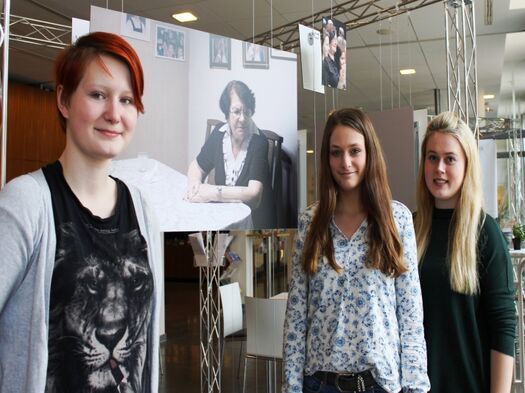Homefinder

History brought to life
Exhibition "Heimatsucher" makes past tangible with personal fates
Osnabrück, April 3, 2017
At first there is silence for a brief moment. Then Alina Stamm says, "What we were taught in class has just been given a face." Together with nine classmates from the vocational schools at Marienheim Osnabrück-Sutthausen (BBS Marienheim), the young woman has been viewing the "Heimatsucher" exhibition. Based on personal narratives of survivors of persecution by the National Socialists, this exhibition makes history comprehensible. The stories show that those affected were torn from a normal life, how they fought for their lives and how they tried to come to terms with the trauma and return to normality after the Second World War.
Michael Prior is impressed by the "Heimatsucher" exhibition and by the work of the association of the same name: "It's great that so many young people are dealing with the subject, how they have absorbed the stories and are now conveying them," says the managing director of the Friedel & Gisela Bohnenkamp Foundation. The foundation is providing financial support for the exhibition to be on display at the Osnabrück Forum am Dom until April 9.
Founded in 2010 as a study project, "Heimatsucher" primarily involves young people conveying the history of those persecuted under National Socialism. They visit the survivors, listen to their stories, write them down and pass them on with the help of exhibitions and school visits. After all, there are not many direct eyewitnesses left, and there are fewer and fewer as time goes on. So that living history does not fall silent, the "home seekers" continue to tell their personal life stories and thus become "second witnesses.
Like Vanessa Eisenhardt, who guides the students of the BBS Marienheim through the exhibition in the Forum am Dom and then encourages them to take a closer look at a person from the exhibition in small groups and then present their fate in a short talk. "Compassion provides a different approach than numbers," says the student from Dortmund, who has been active in the "Heimatsucher" association since 2015, and she adds, "We get a lot back from the classes."
"We are currently organizing a project week at school about habitats," says Inta Knor, a teacher at BBS Marienheim, explaining the reason for her class's visit to the exhibition. One of the topics was the concept of home and the question of what happens to people who have to leave their homeland. "That's when this exhibition came in handy," says Knor, who also visited the Felix Nussbaum House and a shelter for refugees with her group. "A couple of refugees asked us how we managed to rebuild the country after World War II," Lea Mohs says of a moment that brought history into today.
Together with Klara-Sophie Löhr and Alina Stamm, Lea prepared Frieda Kliger's life story for a short presentation. The three are visibly impressed by the woman who had lived in the Warsaw ghetto and crossed the death strip to stay with her family when the ghetto was liquidated. Yet she survived and went to Israel with her husband after the war. At the end of the tour, when Vanessa Eisenhardt encourages the students to write a letter to a person in the exhibition, the three of them also sit down and write a few lines to Frieda Kliger. "This concept of a novel approach to the National Socialist era is having a great effect," says Michael Prior.
The exhibition "Heimatsucher" can be seen until Sunday, April 9, at the Forum am Dom. Some guided tours for school classes (from grade 4) and other groups are still available on request. Opening hours: Tuesday through Sunday, 10 a.m. to 6 p.m. Contact: 0541/318-280. More at www.heimatsucher.eu